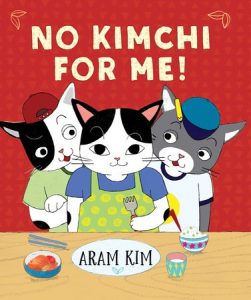 No Kimchi for Me!
No Kimchi for Me!
Written and illustrated by Aram Kim
Holiday House, 2017, 40 pp
ISBN: 978-0823437627
The story of No Kimchi for Me! begins on a rainy day as Yoomi looks through the window while her two brothers work on their summer homework in the attic. Their grandmother calls them for lunch. Yoomi likes her grandmother’s food but she does not like kimchi because she finds this dish stinky and spicy. Her brother Jun teases Yoomi, saying that she is a baby for not being able to eat kimchi. Yoomi’s other brother Yoon adds that only big kids have the ability to eat kimchi. Yoomi uses a fork and puts kimchi in her mouth to prove that she can eat it, but she spits it out. Their grandmother gives Yoomi a glass of water while Jun and Yoon continue to call their sister a baby. After lunch, Jun and Yoon refuse to let Yoomi play with them, saying that what they are doing is not for babies. Angered from being ostracized, Yoomi tries to eat kimchi by hiding it inside a chocolate chip cookie, a slice of pizza, and ice cream. When all her attempts fail, Yoomi screams out loud in frustration. Yoomi’s grandmother comes up with a plan to help her, and they cook a large kimchi pancake together. The delicious scent from the kimchi pancake attracts Yoomi’s brothers to the kitchen, and their grandmother puts it on a large plate. Yoomi carefully tries some of the kimchi pancake, and although it is still spicy, the food tastes yummy to her, so she has successfully eaten kimchi. Together, they all share the big kimchi pancake as the rain slowly begins to stop. The story ends with the illustration of an empty plate on the table and Yoomi playing with her brothers outside where there is a vibrant rainbow in the sky.
The characters are depicted as cats dressed in modern human outfits. This personification can create countless possibilities around Yoomi’s cultural identity. For example, Yoomi could be a Korean child living outside of her home country, a Korean American, an adopted child who may or may not be Korean, a biracial, or a multiethnic girl. Thus, this element enables the story to be more inclusive. The illustrations in pastel and colored pencil are incredibly detailed with vivid drawings of foods, toys, and facial expressions. Moreover, some of the text uses capital or bold letters to emphasize certain words and sentences. An example is when Yoomi’s grandmother states that the kimchi pancake is especially “FOR OUR BIG GIRL!”
The plot enables readers to understand that not all people with a Korean cultural background may necessarily like spicy kimchi. Thus, the story is able to challenge the stereotype that Koreans mostly enjoy spicy kimchi. However, there is not enough information about kimchi in this book for readers who may not know this Korean dish. The written text describes kimchi as something “stinky” and “spicy.” The front endpaper shows several vegetables that are used to create kimchi in Korea. The back endpaper presents illustrations of twelve different types of kimchi. For example, cucumbers are used for Oisobagi (cucumber kimchi), perilla leaves for Kkaennip kimchi, and Korean radishes for Dongchimi and Kkakdugi. The napa cabbage is the main ingredient for making Baechu Kimchi, which is the kimchi that the protagonist Yoomi initially experienced difficulties eating due to its spiciness. The napa cabbage is also used to create Baek Kimchi, also known as White Kimchi. The copyright page explains that the endpapers were reviewed by The Korea Society and a representative of the Korean-American Grocers Association of New York.
Despite the informative illustrations of kimchi, some readers may not be able to connect the vegetables with the type of kimchi. Therefore, there is a concern that another stereotype might be created that every kind of kimchi tastes hot. The kimchi presented in the plot of the story is Baechu Kimchi. While Baechu Kimchi is the most common kimchi in Korea, the book does not provide explanations about the other eleven types of kimchi. Although the non-spicy Baek Kimch (White Kimchi) and mild Dongchimi are illustrated on the back endpapers, descriptions of these kinds of kimchi are missing. Since kimchi is not always spicy, this book can encourage further explorations around different types of kimchi and their level of spiciness.
No Kimchi for Me! shares a cooking recipe for Kimchi pancakes from Eunsook Lee, the author’s mother. The recipe is easy to follow and tastes delightful. This book could make a great pair with other Korean books that share cooking recipes like Bee-Bim Bop! by Linda Sue Park (2008) and Sunday Funday in Koreatown also by Aram Kim (2021). Bee-Bim Bop! includes a recipe for Bee-bim-bop, a traditional Korean dish that mixes rice with vegetables, meat, Gochujang (red pepper paste), and sesame oil. Sunday Funday in Koreatown provides a recipe for Kimbap (Korean Seaweed Rice Rolls). By pairing these books, families and educators could read interesting stories while also making delicious Korean food together.
Author and illustrator Aram Kim was born in Cincinnati, Ohio. Her family moved back to South Korea when she was two years old. She has received a bachelor’s in English Literature from Yonsei University in Seoul, and a master’s in Illustration as Visual Essay from the School of Visual Arts in New York. She is an art director of the picturebook team at Macmillan Children’s Publishing Group and currently lives in Queens, New York. Additional information about the author can be found online at: https://www.aramkim.com/
Hyunjung Lee, University of Arizona
© 2022 by Hyunjung Lee

WOW Review, Volume XV, Issue 1 by Worlds of Words is licensed under a Creative Commons Attribution-NonCommercial-ShareAlike 4.0 International License. Based on work by Hyunjung Lee at https://wowlit.org/on-line-publications/review/xv-1/6
WOW review: reading across cultures
ISSN 2577-0527
